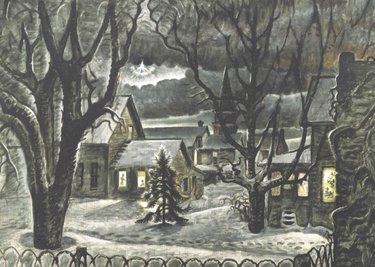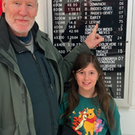A voice from the past: A trip to Schoharie
“At certain times when the snow is new, the countryside briefly regains its unity and freshness,” writes Ed Cowley Jr. “It is particularly impressive on dark nights.” This painting is by Cowley’s friend and mentor, the late Charles E. Burchfield; it is titled “The Star” and was painted in the 1940s.
Editor’s Note: Ed Cowley Jr., an Altamont artist who chaired the University at Albany art department, died on Oct. 11, 2014 at the age of 89. He was a frequent contributor to The Enterprise. His son, Ed Cowley III, who curates his father’s work, recently came across this never-before-published letter, which his father wrote in the mid-1970s. How much has changed in the half-century since Ed Cowley Jr. wrote this?
To the Editor:
On Dec. 4, I rode from Altamont to Schoharie to schedule a driving test for my daughter, Kathy. The only town we passed was Gallupville, and Gallupville is passed before you ever have a chance to think about Gallupville.
The natural scenery is delightful — there are rolling hills and flat expanses where some of the views are like calendars used to be in the days when calendar art was made. The sun was bright and the sky was clear and the air was chilled.
For many years the encroachment of outdoor advertising on our outdoors has, for me, been an increasing source of dismay, but on this road to my quiet joy there are hardly any signs at all — well that is with the exception of a sign in Schoharie that appears to advertise a business that no longer exists — a sign of sentiment perhaps.
As Kathy was driving, I was free to look about and everywhere I looked I saw trailers — every hill and valley seems to have a trailer, and each was situated for convenient access to the highway. There were single trailers, doubles, and I even think I saw three trailers connected in a horseshoe formation — although maybe I’m making that up.
Frankly, I don’t know how we got to where people must buy trailers rather than build small houses. I recognize it has a lot to do with the economy and the availability of trailers as a complete item much like a live-in car that you can park in a rented space and to which you may add amenities like electricity, or water as they can be afforded.
Frequently, the trailers are carved out of woodland and the trees are usually cut in a larger rectangle than the trailer itself. Which unfortunately attracts even more attention to the terrible imposition that the trailers force on nature.
In any event, the results indicate that great numbers of trailers have been produced and sold and strung about the countryside. It is possible to confine trailers to certain areas. It would be very helpful aesthetically if they could be consolidated in properly landscaped communities.
Actually they do seem to be making new designs that look more and more like houses, which is an improvement of sorts. No doubt there are those who would wonder why the unchecked proliferation of trailers should even be questioned.
After all, trailers are not physically harmful like pesticides, the Vietnam war, heroin, and mugging.
Perhaps what is most discouraging is to see the many beautiful 19th-Century homes that are a part of this visual smorgasbord. It is the sharp contrast of what could be with that is that provides the shock. The comparison is a lesson in the art of architecture, and you don’t need any special training to recognize that something has gone wrong.
The sun shone on the 19th-Century houses, many of which were white wood or red brick, and they looked great. The craftsmanship and thoughtful planning is so evident that you can share the pride of their builders.
The old houses were well located for sun and shadow and many have views we would label as picturesque. The old houses do have the advantage of mature landscaping so that they are now seen at their very best.
For many years, the modern movement laughed at calendar art and the picturesque was sacrificed for the functional and arguments raged over the uselessness of decoration, and while all of this was going on the people proceeded to buy the best deal, and the best deal turned out to be the trailer.
Coming back from Schoharie, we headed down the old road past the historic old Stone Fort, and we discovered the old bridge was closed. This too was sad, as the old bridge ran through a pleasant tree-lined street, and it was nice that it was there.
I’m sure there must be economic reasons why an old bridge should be closed, and perhaps even enough reasons why it should eventually be bulldozed out of the rush of progress. The bridge probably wasn’t strong enough to take the weight of trailers anyhow.
As we moved back down to Altamont, the beer cans and discarded bottles on either side of the road increased in number and prominence. The concerned hand of the artist is rarely seen.
With exception of the older buildings, almost everything that society has done serves only to mock, torture, and torment the beauty that nature gave us to work with — we cut down trees, trim them, and then put them back up in lines that run by the road. We hang wires from the poles and slice the sky with black threads and ribbons.
There is little sense of planning and no indication of concern over what our visual impact on nature actually is. To some extent, man does have dominion over nature, but somehow we are literally losing ground.
There are ironic aspects like the romantic ideal images of Christmas cards and the promotional examples often used in TV. There are sleigh bells tinkling, glowing fireplaces, sentimental attachment to the good old days — the paradox builds and expands until finally it erupts into the absurd reality of today.
There are many things that shape our plight. It is our nomadic lifestyle, our illusion of independence, a common disregard for quality, and lastly an omnipresent bureaucracy built largely on regulations without values.
The automobile has made it possible for us to look so far beyond our neighbors that we have managed to lose our sense of community. We are in a continuous and compulsive search for greener pastures, or a plastic equivalent.
The drive from Altamont to Schoharie is not bad by the usual standards. I chose it simply because it is characteristic of most country roads.
To look on the bright side, there is an advantage that we have in this northern climate we share, and that is the winter snow. At certain times when the snow is new, the countryside briefly regains its unity and freshness. It is particularly impressive on dark nights.
Edward Cowley Jr.
Altamont

